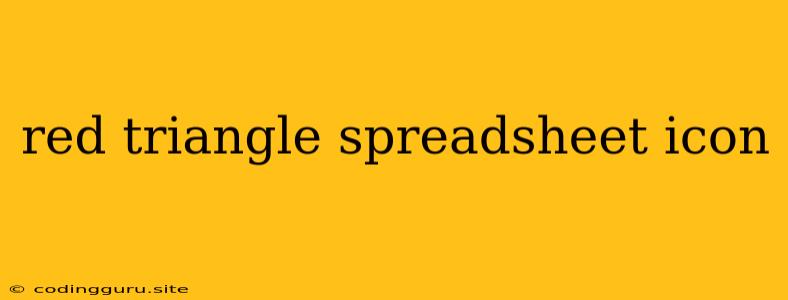The Red Triangle Spreadsheet Icon: What Does It Mean?
Have you ever opened a spreadsheet in Google Sheets or Microsoft Excel and noticed a red triangle icon next to a cell? This icon can be a little alarming, but it usually indicates that there's an error in the formula or data within that cell.
This article will explore the common reasons why this red triangle appears, what it means, and how you can troubleshoot and fix the error.
Why Does the Red Triangle Appear?
The red triangle icon is a visual indicator that a cell contains an error, but it doesn't tell you exactly what the error is. To understand the problem, you'll need to hover your mouse over the red triangle. This will display a tooltip that provides a brief description of the error.
Here are some of the most common errors that trigger the red triangle:
1. #DIV/0! Error: This error occurs when a formula attempts to divide a number by zero. For example, if you have a formula like =A1/B1 and the value in cell B1 is zero, the result will be "#DIV/0!".
2. #VALUE! Error: This error occurs when a formula is trying to perform an operation on data that is not of the correct type. For example, if you try to add a number to a text string, you'll get a #VALUE! error.
3. #REF! Error: This error occurs when a formula refers to a cell that no longer exists. For example, if you delete a row or column containing a cell referenced by a formula, the formula will result in a #REF! error.
4. #NAME? Error: This error occurs when a formula contains a misspelled function name or a reference to a cell that doesn't exist.
5. #NUM! Error: This error occurs when a formula is trying to perform a calculation that results in a number that is outside the allowed range for the calculation. For example, if you try to calculate the square root of a negative number, you'll get a #NUM! error.
6. #N/A Error: This error occurs when a formula cannot find a value. For example, if you're using the VLOOKUP function to search for a value that doesn't exist in the lookup range, you'll get a #N/A error.
How To Fix the Red Triangle
Once you know what type of error you're dealing with, you can start to troubleshoot and fix it.
1. Check Your Formulas: Carefully review the formula in the cell with the red triangle. Look for any typos, incorrect references, or incorrect function arguments. Make sure the formula is using the correct data types and that the referenced cells exist.
2. Check Your Data: If the error is related to the data in the cell, make sure the data is accurate and in the correct format. For example, if you are entering a number, make sure you're not entering a text string instead.
3. Use the Error Handling Functions: Spreadsheets offer several error handling functions that can help you manage and control errors. Some common functions include:
* **IFERROR:** This function allows you to specify an alternative value to display if a formula results in an error.
* **ISERROR:** This function returns TRUE if a value is an error and FALSE if it is not.
4. Use Data Validation: Data validation allows you to set specific rules for the type of data that can be entered into a cell. This can help prevent errors from occurring in the first place.
5. Review Your Data Sources: If the error is related to data from an external source, ensure the data is accurate and up-to-date.
6. Consult Online Resources: There are many online resources that provide information about the various spreadsheet errors and how to fix them.
Common Scenarios and Solutions
Scenario 1: Dividing by Zero
Let's say you're calculating the average of a list of numbers in a column. You use the formula =SUM(A1:A10)/COUNT(A1:A10). However, one of the cells in the range A1:A10 contains a zero value. The formula will result in a #DIV/0! error.
Solution: You can modify your formula to use the IFERROR function: =IFERROR(SUM(A1:A10)/COUNT(A1:A10), 0). This formula will calculate the average if there is no zero value in the range. If there is a zero value, the formula will return a value of 0.
Scenario 2: Incorrect Data Types
Imagine you are calculating the total cost of items in a list. You have the quantity in column A and the unit price in column B. You use the formula =A1*B1 to calculate the total cost. But one of the cells in column B contains a text string instead of a number. This will result in a #VALUE! error.
Solution: Use the VALUE function to convert the text string in column B to a numeric value: =A1*VALUE(B1). This will ensure that the calculation is performed correctly.
Scenario 3: Missing or Deleted Cells
You have a formula that refers to cells in a particular row. If you delete that row, the formula will refer to a cell that no longer exists, resulting in a #REF! error.
Solution: Ensure that the referenced cells exist and are not deleted. You can also use the INDIRECT function to refer to cells using a text string instead of a direct cell reference. This can help to avoid errors if cells are deleted or moved.
Conclusion
The red triangle spreadsheet icon is a common indicator of an error, but it doesn't always reveal the specific problem. By understanding the different types of errors and the steps to troubleshoot them, you can identify and fix the error quickly and efficiently. Remember to review your formulas, check your data, use error handling functions, and consult online resources if needed. With a little practice, you'll be able to confidently navigate spreadsheet errors and achieve the desired results.
